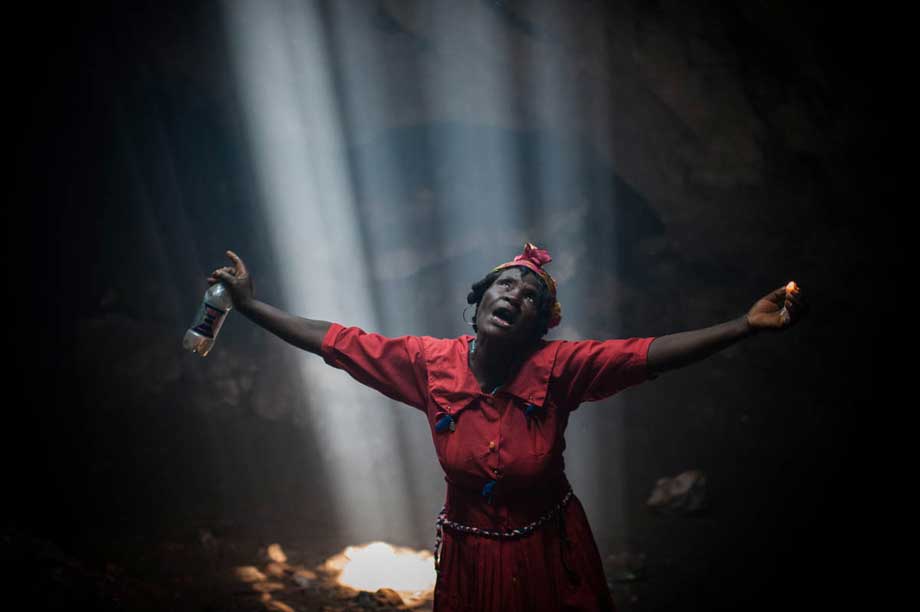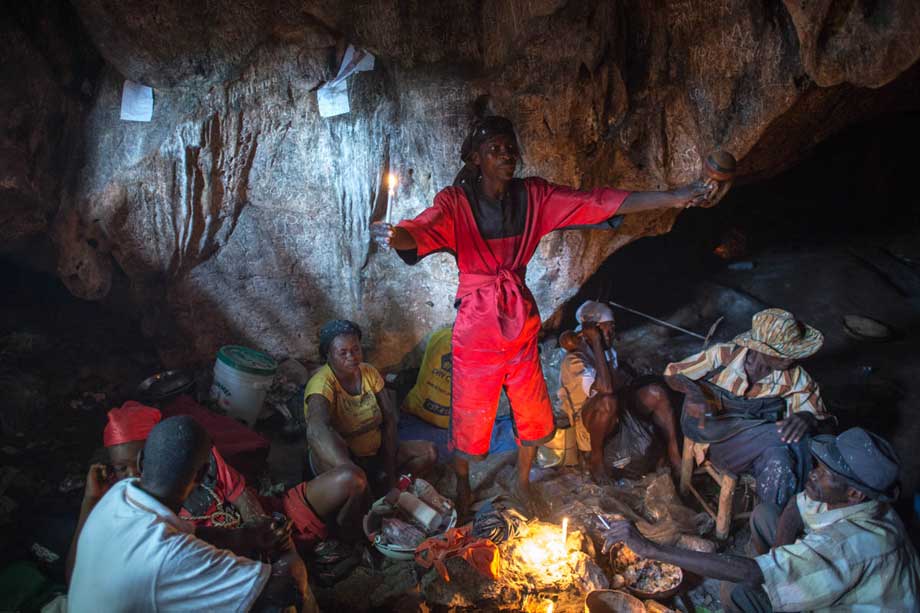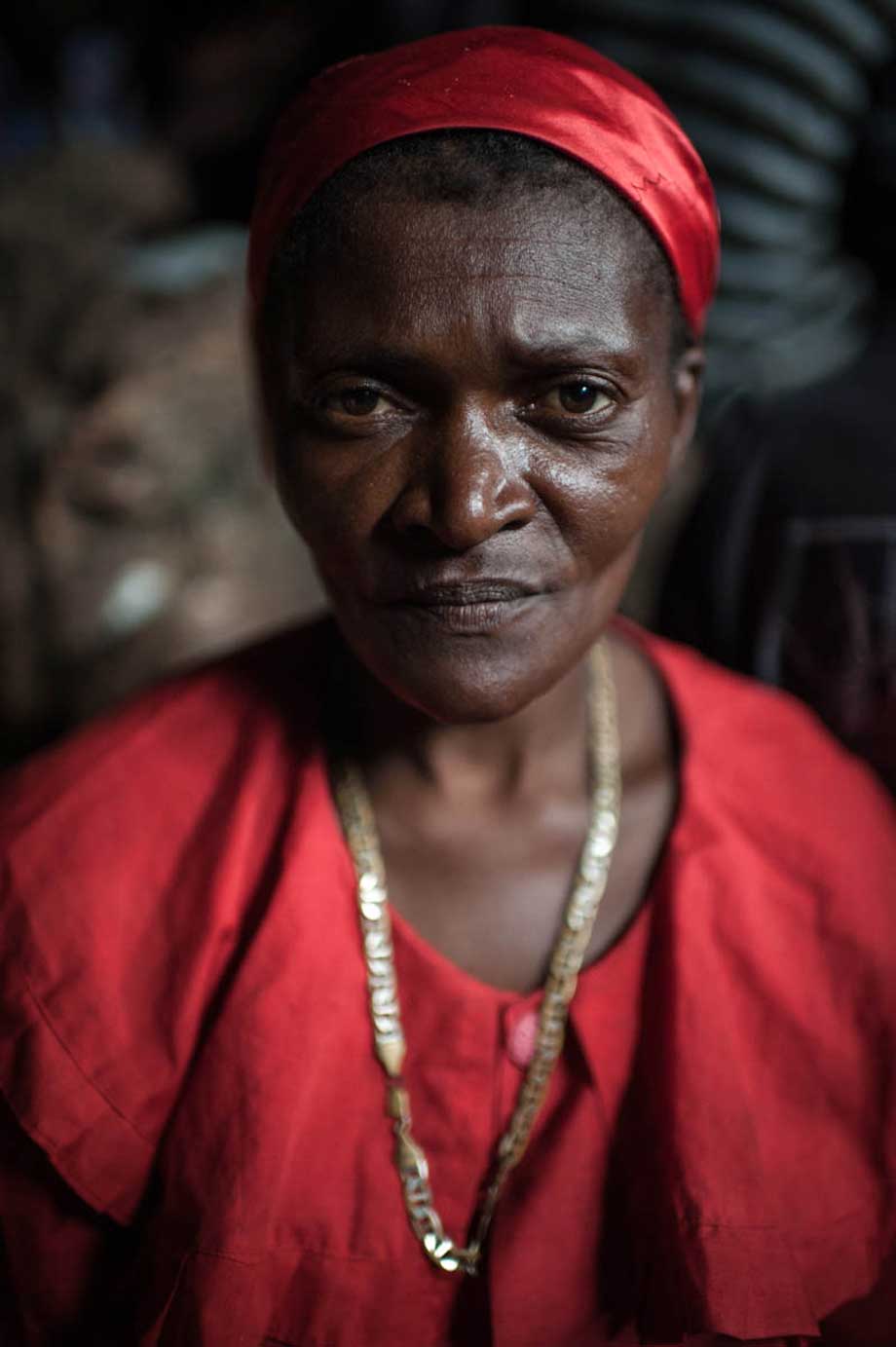In 1998, 16 years after he first became interested in visiting Haiti, photographer
Anthony Karen made his first of what would be many trips to the Caribbean country. In the early 1980s, Karen had seen a documentary about the Creole pig in Haiti. The documentary focused on the United States’ role in the pigs’ eradication due to an outbreak of swine flu in neighboring Dominican Republic and subsequent fear of the U.S. pork industry being devastated
 |
Several times a day, light casts down from an opening at the highest point of the grotto ceiling. During these times, many Voodoo practitioners make their requests to the Loa or Iwa (spirits of Haitian Voodoo). The region's Taino Indians also centered many of their rituals around the same light.
Karen’s travels to Haiti are often for medical missions and volunteer work. During those trips, he also found time to approach people about his interest in attending a Voodoo ceremony. Karen didn’t feel comfortable getting into a private space and photographing the ceremony during his first trip, but as his comfort slowly increased, he began to document the rituals.
Karen finds Voodoo, sometimes written as Vodou by scholars and others who say this spelling is more accurate, to be one of the most organic forms of spirituality he’s witnessed. “The Vodou faith teaches us to bless nature and support cosmic harmony for the purposes of mastering divine magnetism,” he said. “Vodou accepts the existence of the visible and the invisible, in a sense that it is believed that one does not see all that exists, and Vodou is in full compliance with the laws of nature.”
That Voodoo is mostly about black magic or conjuring evil forces is only one of many misconceptions about the religion. While a Bokors, which could be described as a sorcerer of sorts, do exist, Karen said the darker aspects of Voodoo are not common practice. “It’s extremely rare and often looked down upon by many Vodouisants themselves,” he said.
Another common misconception is that animal sacrifice is a widely practiced form of Voodoo. Although Karen did witness and document animal sacrifices, that aspect isn’t embraced by all. Some of the images shown here aren’t representative of the day-to-day practice of many Voodoo followers. The group featured here is based in a remote, rural area, and they practice what they consider to be the Voodoo of their ancestors, which can include animal sacrifice

A Voodoo priest (hougan or houngan) begins to invoke the Loa or Iwa spirits during the feast day of St. Francis of Assisi in a remote region of Haiti.
A Voodoo follower after a moment of prayer.
Depending on the community practicing Voodoo, animal sacrifice is an offering to the spirits (Lwa). Karen said the food is shared with the community after the sacrifice. “Blood and sacrifice aren’t always the most important aspects of the religion,” he said. “The Vodouisant also honors nature as a whole, while including, specifically, trees, mountains, plants and stones. … But regardless of those groups who do use sacrifice as part of their practice, those of us who are omnivores or carnivores would be hypocrites to judge, as we implicitly condone this practice by butchering and eating meat.”
A Voodoo practitioner adheres a prayer to the grotto walls with candle wax during the feast day of St. Francis of Assisi.
Karen said some Haitians blamed Voodoo for the seemingly endless amount of earthquakes and other natural disasters, though he sees people returning to Voodoo for the same reasons others turn to faith: comfort, strength, and self-empowerment, as well as asking for the help and assistance of their ancestors. “Vodou is feared because of ignorance, and it’s unfortunate that it’s chastised as much as it is,” he said.
See more Photos Below
A mambo, a high priestess in Haitian Voodoo, is overcome by a spirit
The life energy of the animal is for the Lwa. Often the blood is collected in a calabash bowl and later placed on the Poto Mitan, which represents the center of the universe and access to the spirit world.

A hougan or houngan uses talc power to refresh and purify a sacrificial offering. The meat and hide will then be eaten and shared among that family or others in need.

A Voodoo follower moments after being released from the Loa or Iwa.

Two followers moments after a spiritual possession and sacrifice.
Culled From Huffington Post |









So primitive!
ReplyDelete